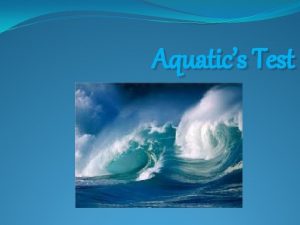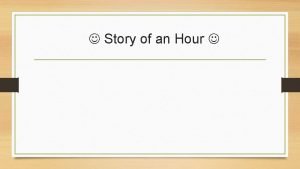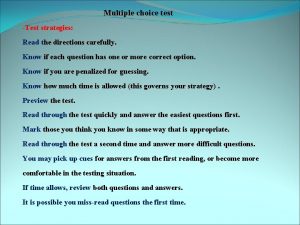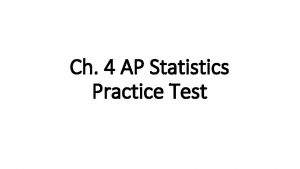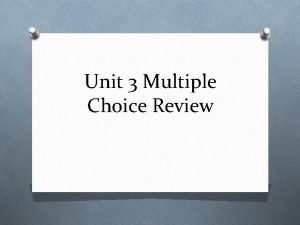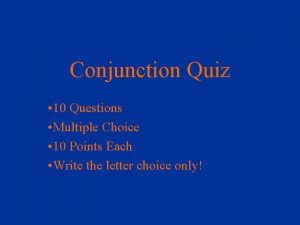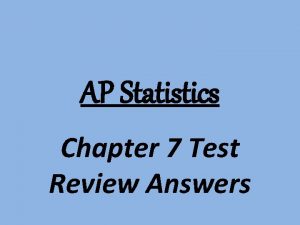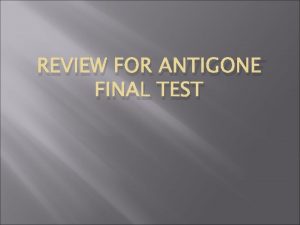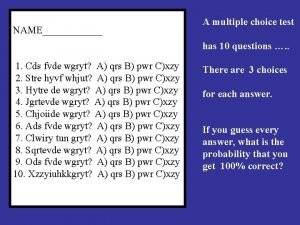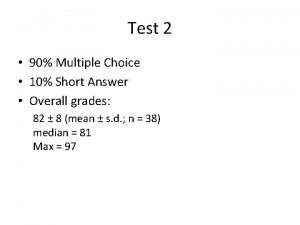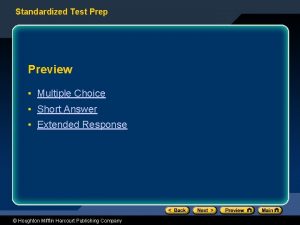Test 2 90 Multiple Choice 10 Short Answer












- Slides: 12

Test 2 • 90% Multiple Choice • 10% Short Answer • Overall grades: 82 ± 8 (mean ± s. d. ; n = 38) median = 81 Max = 97

1 QQ #24 for 8: 30 1. Why are twitches so long in smooth myofibers? 2. In smooth muscle, what is the result of dephosphorylation of a crossbridge while it is still attached to the thin filament? 3. Which of the following can affect membrane potential (and thus contraction) in smooth muscle? a) NE b) EPI c) ACH d) O 2 e) stretch f) H+ 4. How can some smooth muscles produce action potentials without voltage-gated Na+ channels?

1 QQ #24 for 9: 30 1. Slow waves and pacemaker potentials are characteristic of a) Single unit smooth muscles b) Multi-unit smooth muscles c) Muscles of the uterus d) Muscles of the iris 2. How are smooth muscles involved in migraine headaches? 3. Which of the following can affect membrane potential (and thus contraction) in smooth muscle? a) Oxytocin b) EPI c) ACH d) O 2 e) stretch f) Prolactin

S 1 Local control • Muscle spindle – Stretch receptor – Intrafusal muscle fiber • What is their role? • The stretch reflex… – Follow the reflex arc – Be able to differentiate function of afferent fibers, alpha motor neurons, and gamma motor neurons Spindle Afferent

S 2 Fig. 10. 05 ab

S 3 Fig. 10. 05 c Co-activation of alpha and gamma motoneurons insures that the stretch of muscle can be detected regardless of the initial length or state of contraction of that muscle.

S 4 Fig. 10. 06 Stretch reflex is monosynaptic Most common example: patellar reflex = “knee jerk reflex” Proprioception pathway via dorsal column-medial lemniscus pathway

S 5 Fig. 10. 07

S 6 Golgi tendon organs involved in a reflex to oppose excessive muscle tension. Not monosynaptic. Not shown: ascending axons in dorsal column-medial lemniscus tract.

S 7 Joint angle detectors and cutaneous mechanoreceptors contribute to sense of body position (proproiception. )

S 8 Pyramidal tract Fig. 10. 12 Corticospinal tract Corticobulbar tract Fine motor control, esp. of extremeties Extra-Pyramidal tracts Reticulospinal tract Vestibulospinal tract Originate in brainstem, more involved with posture and equilibrium Not monosynaptic! This diagram is overly simplistic.

S 9 Who Cares? Video of Huntington’s Chorea Video of Cerebellar Dysfunction Video of Trampoline Championship
 Short short short long long long short short short
Short short short long long long short short short Multiple choice choose the best answer
Multiple choice choose the best answer The story of an hour multiple choice questions
The story of an hour multiple choice questions Direction in multiple choice
Direction in multiple choice Tonya wanted to estimate the average amount
Tonya wanted to estimate the average amount Polynomials multiple choice test doc
Polynomials multiple choice test doc Who disturbed the watch of the elsinore guards
Who disturbed the watch of the elsinore guards Ap lit practice test multiple-choice
Ap lit practice test multiple-choice Conjunction test multiple choice
Conjunction test multiple choice Ap stats chapter 7 review answers
Ap stats chapter 7 review answers Math multiple choice test taking strategies
Math multiple choice test taking strategies What is choragos final advice
What is choragos final advice A multiple choice test has 10 questions
A multiple choice test has 10 questions

